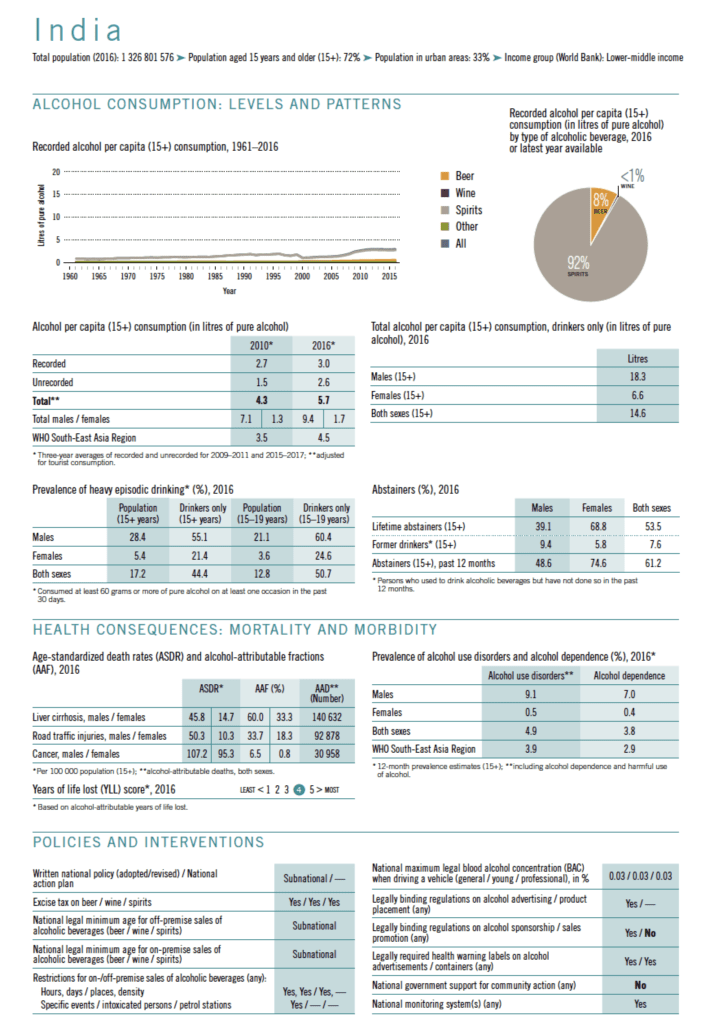Big Alcohol has exploited the COVID-19 pandemic in India to convert women to alcohol consumption. The vast majority of women in India live alcohol-free. The World Health Organization reports that in 2016 almost three-quarters of the female population in India over 15 years of age lived alcohol-free (74.6% past 12 months alcohol abstainers; 68.8% lifetime alcohol abstainers).

From bad to worse: Watering down of state alcohol laws
In India, state governments control alcohol policies. Prior to the pandemic, state alcohol laws did not allow for alcohol e-commerce. During the COVID-19 pandemic, Big Alcohol pushed Indian states to weaken alcohol laws and allow online alcohol sales and home delivery. This is further increasing the availability of alcohol.
Meanwhile, the COVID-19 pandemic was a prolonged stressful condition for all people, but especially for women. As The New Indian Express reports, women were almost three times more likely than men to be looking after children full-time, managing household chores and professional responsibilities on their own during the pandemic.
Stressful events correlate with higher levels of alcohol consumption at the population level,” said Prince Singhal, Founder, of Community Against Drunken Driving (CADD), as per The New Indian Express.
The situations in Indian homes during COVID-19 significantly affected collective mental health. For many people, social disconnection, financial strain, increased obligations in the home, and ongoing uncertainty created distress.”
Prince Singhal, Founder, Community Against Drunken Driving (CADD)
The alcohol industry increased the availability of alcohol products during this stressful time, exploiting the pandemic to sell alcohol as a coping mechanism. In India, this strategy has converted more women to alcohol consumption.
While women consume less alcohol than men, a new survey shows more women reported increasing alcohol use since the pandemic.
The survey of 5000 women in Delhi conducted by the Community Against Drunken Driving (CADD) found:
The women who were most at risk of increased alcohol use in India were women with young kids, those who were employed, those from higher-income groups, and those who suffered from depression and anxiety.
The survey reveals how effective alcohol industry efforts are to turn women, especially already vulnerable women into alcohol user:
- 37.6% of women reported that their alcohol consumption increased.
- 62.5% reported spending more on alcohol.
- 45.7% of women reported stress as a reason for using alcohol products.
- 34.4% reported increased alcohol availability as the cause for alcohol use.
- Over 77% of women reported better retail shops, home delivery, buy one get one (BOGO) offers, and discounts made buying alcohol products more attractive.
- Almost 7% reported at-risk or heavy alcohol use.
Alcohol harms women more but Big Alcohol does not care
The alcohol industry targets women while knowing the very specific harms their products and practices cause to women, including higher susceptibility to addiction from lower amounts of alcohol and risk of breast cancer already from small amounts of alcohol consumption.
Big Alcohol targeting women is not a new strategy. Movendi International has exposed how the alcohol industry attempts to convert more women to consume their products – specifically in countries of the global South where most women live alcohol-free.
After years of objectifying women to sell alcohol to men now, the alcohol industry attempts to hijack feminism and women’s empowerment to sell alcohol to women.
The following two special features cover the issue in depth.
The first Special Feature exposes how Big Alcohol is trying to invade feminism and women’s empowerment, specifically by piggybacking on days such as International Women’s Day or the International Day for the Elimination of Violance against Women.
This second Special Feature exposes Big Alcohol’s predatory marketing. It reveals the alcohol industry’s shift from sexualizing to gendered alcohol advertising in pursuit of female consumers.
Big Alcohol and COVID-19 in India
During the initial COVID-19 lockdown in India, the government put in place common sense limits on alcohol retail to help stop the spread of the virus. When the lockdown was lifted several states re-opened alcohol retail. This led to crowding of liquor outlets which could threaten an increase in virus spread. The alcohol industry exploited this reason to push for online sales, which eventually increased alcohol availability and harm in India.
India’s alcohol burden was already heavy before the pandemic. Since the pandemic began the lethal interaction of alcohol with the coronavirus has made matters worse.
- In 2017, alcohol was responsible for more than 580,000 deaths in India, according to the Global Burden of Disease Study.
- The three leading causes of alcohol-attributable deaths in India are tuberculosis, road injuries, and self-harm.
- According to a report by the Ministry of Social Justice and Empowerment (MoSJE) of India, every third alcohol user in India needs help for alcohol use problems and only about 1 in 38 people with alcohol dependence, report getting any treatment or help.
- A modelling study in 2019 found that economically India loses 1.45% of its GDP due to alcohol. This is more than the country’s entire health spending which is 1.28% of its GDP. In numbers, between 2011–2050 India stands to lose US$2.2 trillion – accounting for tax revenues – due to alcohol costs
Alcohol e-commerce in India since the pandemic
After the COVID-19 lockdown was lifted, most of the alcohol e-commerce in India stopped. It is unclear if alcohol e-commerce is now legal even after the pandemic. It is likely that laws vary from state to state. There are some e-commerce platforms that are still selling alcohol in India, mostly in urban areas such as Mumbai, Delhi, and Bangalore.
Alcohol and COVID-19
The World Health Organization specifically advised reducing alcohol availability during the pandemic to stop the spread of the virus, reduce the burden on healthcare and emergency services, and to reduce individual susceptibility to COVID-19 complications.
A groundbreaking report detailed the lethal interaction between alcohol industry products and practices and the COVID-19 pandemic.